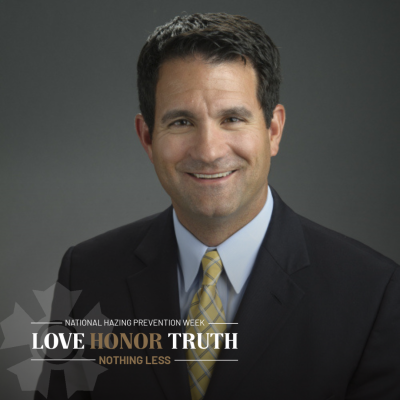Doing the Hard Right Thing
By Dr. Matthew R. Caires (Washington State)
Dean of Students, Montana State University
 It was 32 years ago this fall that I joined Sigma Nu (Delta Iota – Washington State). After graduating in 1997, and for the last 27 years, I have worked in some capacity or another in the dean of students office at a variety of different colleges and universities. Throughout all that time, I’ve seen the continuum of hazing cases and their impact on young people, from silly and seemingly non-harmful hazing to incidents that include criminal activities and deeply harmful and life-threatening incidents.
It was 32 years ago this fall that I joined Sigma Nu (Delta Iota – Washington State). After graduating in 1997, and for the last 27 years, I have worked in some capacity or another in the dean of students office at a variety of different colleges and universities. Throughout all that time, I’ve seen the continuum of hazing cases and their impact on young people, from silly and seemingly non-harmful hazing to incidents that include criminal activities and deeply harmful and life-threatening incidents.
During all that time, I’ve come to believe two things about hazing on college campuses. First, no one joins a student organization, be it military, music, athletic, fraternal, or social, to be exposed to hazing. Second, the vast majority of individuals who lead hazing activities are not bad people. Instead, they’ve been exposed to negative experiences that evolve into dangerous, illegal, and harmful traditions.
Before I explain, let’s acknowledge why hazing continues to be a problem on college campuses. One of the real challenges with reducing and preventing hazing is educating young people about what it means to haze. Most hazing incidents that I have investigated or researched have their beginnings in group bonding or team building activities. And isn’t group bonding and team building a good thing? We want students to build bonds that will lead to academic support and life-long friendships. But how do these helpful activities turn into dangerous hazing events?
Any time there are “secret” or “confidential” activities involved with student organizations, as in ritual or initiation rites that are common in fraternal organizations, hazing can become a real problem. The reason this occurs, in my experience, is what I call “one-up-mans-ship.” That is, when a group of young people go through a shared bonding experience and come through the other side, they tend to recalibrate the experience and make it a little “tougher” for next year’s new members.
“Well, we had to do X, Y, & Z as new members, wouldn’t it be cool if next year’s guys had to do X, Y, & Z plus this new difficult thing to make them bond even more?” This type of thinking and behavior doesn’t take long before innocent group bonding evolves into experiences that are dangerous, illegal, and even life-threatening.
Stopping this slow and pernicious slide down the slippery slope of activities as they evolve into hazing is critical. Having dedicated communication mechanisms in place where students can report activities of concern, especially in anonymous ways, is an important place to start. New members in student organizations need to be informed of these communication mechanisms at their first meeting. Upper-class students who lead new member group bonding activities should regularly ask themselves these questions:
- Are we hiding details about the proposed bonding activities from the new members? (if yes, it’s probably hazing)
- Would we tell our parents, headquarters, or college/alumni advisors about the proposed bonding activities? (if no, it’s probably hazing)
- Would we be okay if the campus student newspaper reported our proposed bonding activities on the front page? (if no, it’s probably hazing)
I fully recognize that reporting hazing activities, even innocuous or “minor” hazing activities, can be extremely difficult for new members. Peer pressure is very real, and standing up and risking your newfound friends and social standing is a major deterrent to many college students reporting activities of concern. We need student leaders who have been exposed to hazing activities to make internal changes in their organization and recalibrate new member bonding activities. According to recent research by Gallup and the NIC, 75% of all fraternity members stated that they gained leadership experiences in their chapter. The time is now to use these leadership skills to end hazing activities, even the silly ones. It only takes a few years for silly behavior to evolve into risky hazing.
I am reminded that 32 years ago I first learned about three brave young men who stood up to incredible peer pressure and started a new student organization challenging the hazing activities they encountered at the Virginia Military Institute. Don’t forget we have role models in Hopkins, Riley, and Quarles – students who did the hard right thing - and look how things turned out. My life is forever changed, and so are the lives of over 265,000 others, because of the actions of these men of character who stood up to hazing and peer pressure and created the Legion of Honor.